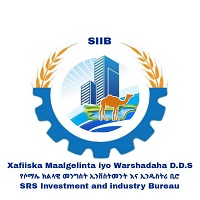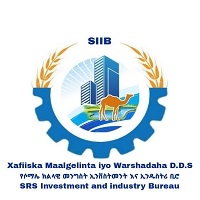Agriculture
Crop production potential
The region has four major rivers, Wabi Shebelle, Genale, Dawa and Weyib which carry large amount of water throughout the year. The region has also high underground water potential.
Sorghum and maize are the two staple food crops invariably cultivated by all farmers in the region, whether lowland or highland. Other lowland crops such as sesame, groundnut, cotton and fruits like papaya, mango and some citrus are grown in scattered manner. Highland crops such as millet, teff, wheat and barley are cultivated along with some highland fruits by highland farmers in some parts of Jigjiga, Shinile, Liben and Afder zones.
About 70% of the rural population of the Somali Region are predominately pastoralists. The remaining rural population are agro-pastoralist (18%) practicing both livestock rearing and crop production, and pure crop producers (12%) depending on the production of the different crops.
The agro-climatic condition of the region allow diversifying agricultural products by growing a variety of food crops that are adaptable to the agro-ecological zones of the region either under irrigation or rain fed. However, the large tract of cultivable area of which very small is currently under cultivation. The major crops that can be grown in the region include the following:-
-
Cereal crops (maize, sorghum, millet and wheat),
-
Oil crops (groundnut, sesame & castor oil),
-
Pulses (pigeon pea, chick pea and mung bean),
-
Industrial crops (cotton, sugar cane, tobacco, sisal and kenaf),
-
Vegetables and fruits (green bean, sweet potato, muskmelon, asparagus, banana, papaya and grapes),
-
Flowers,
-
Insecticide plants,
-
Agro forestry
Livestock, apiculture and fish resources
Livestock is a very important and critically required resource for the well being of the Somali society. The main species reared in the region include cattle, sheep, goats, equine and camels. There are three district types of livestock production system based on the prevailing climatic conditions of the rangeland in the region. These are crop based mixed farming system, livestock based mixed farming system and pastoralist.
There is no reliable data on the livestock population of the region. According to the estimate made by the socio-economic survey conducted in the region by IPS, the total population of livestock in the region is about 6,874,000 TLU, out of which cattle constitute about 44%, camel (30%), sheep (13%), goats (12%). The average density of cattle per km2 of total area is about 11.7 which ranges from 4.9/km2 in Warder zone to 22.4/km2 in Jigjiga zone.
Cattle are the most important livestock species in the region by their dual product of milk and meat. Small ruminants are the next most important animals that produce food and generate income. Camels play significant role as a source of milk, meat and cash reserves.
Livestock mortality rate is very high owing to such factors as shortage of feed and water during the dry and drought periods, diseases, plant poisoning etc.
The prime feed resource available to the livestock in the region is natural vegetation. The contribution of crop residues and aftermath grazing of cropped lands are negligible. The overall sources of feed are not sufficient to support the livestock population found in the region at least during parts of the dry season.
Fishery is almost forgotten sub-sector in the region although rivers like Wabi Shebelle, Weyib and Dawa are expected to have huge fish potential.
Forest resources
The Somali Region is endowed with natural resources including bio-diversity which is rich in species of plants and animals. Of the entire flora in Ethiopia, 25% are represented in the region and 18% of these are endemic to the region and 135 plant families, 626 genera and species of plants are recorded in the region. There are also a number of mammals, birds, reptiles, amphibians which are adapted to the arid and semi-arid conditions of the region.
The region is known to have the potential for natural gum and incense yielding tree species that are dominant in Liben, Fiq and Afder zones as well as Gode and Korahe zones. The wild animals which are known to exist in the region include lion, hyena, leopard, fox, hunting dog, crocodile, oryx, zebra, baboon, giraffe ostrich, hippopotamus, monkey and a variety of birds.
The main climax vegetation classes in the region are:-
-
Acacia - bussel open woodland,
-
Accacia - commiphora bushland,
-
Ever-green/semi-ever-green scrubland,
-
Semi-desert Acacia bussel scrab land, and
-
Riparian forests.
Presently the forest resources of the region are used as fodder for livestock, source of bio-fuels, construction materials, traditional medicines and source of natural gum, incense and myrrh.
Despite their importance for local economies and the livelihood of the people, the forest resources of the region are neglected.
Agricultural Marketing
Marketing of agricultural products is analyzed by considering the situation in each zone of the region. Marketing of various agricultural products such as grains, live animals, hides and skins, honey, fruits and vegetables, forest products are practiced in the region to a varying degree. Observation of the data collected on prices of the products revealed the existence of price fluctuation.
Factors such as food availability situation in the neighbouring Somalia Republic, and distribution of relief food at the refugee centers have significant impact on the supply and prices of grain in the area.
With respect to livestock marketing, most of livestock marketing is through smuggling. Absence of resting places, the poor communication system coupled with lack of trucks to transport the live animals is the major constraints to live animal trade. With respect to other agricultural products, the export market to the neighbouring countries is not yet exploited and hence expansion of the various agricultural commodities cannot be hampered by lack of marketing outlet in the future.
As far as grain marketing is concerned, the Somali Region is not surplus producing and consequently possibility of its supplying grain to other regions is very remote at the moment. However, to encourage flow of grain into the region, an enabling environment should be created to encourage private grain dealers.
The Erer Woreda has a high potential for fruits and vegetables production under irrigation. In this regard the markets of Dire Dawa and the export market of Djibouti can still absorb increased production.
The Liben Zone has a high potential for the production of natural gum and different incenses. However, the marketing of these products has not been developed starting from harvesting up to sales. Hence, concerned Bureaus need to organize strong extension system staffed with trained personnel who follow-up and demonstrate to those involved in the collection the best way of harvesting and selling including the organization of service co-operatives.
Livestock marketing centers in the region are not well organized and lack basic facilities. The extent of illegal livestock trade in the region is of an alarming proportion. In order to promote livestock trade in the region, there should be regulations which involve, among others, the establishment and maintenance of organized livestock markets and slaughter facilities and collection of levies on these services as well as regulations which pertain to livestock movement and mode of its transport.
Mineral, energy and water resources
Mineral resources
Various exploration works conducted in the past revealed the existence of various major and minor mineral occurrences in the Somali Region. The major mineral occurrences and deposits identified in the region include salt, gold, feldspar, mica and natural gas. There are also minor occurrences such as graphite, kaolin, magnetite, talc, phosphoric and gemstone.
Major salt occurrences are identified in three localities of the region, viz. Afder, Boji-dol and El-dere. Minor occurrences are also reported at Dolo-Odo, Melka-Softu, Sede and Kenere localities in Liben and Afder zones. Most of the occurrences are in brine form.
The geological favourability for primary gold deposit coupled with eluvial, deluvial and alluvial placer gold mining by local inhabitants attracted the attention of many geologists to the Moyale area. Apart from the potential resources of primary gold in Moyale area, there is a potential of places gold along the banks and steam beds on the eastern side of Moyale within a radius of 15-50 km. between Haramsam and Dukisso localities.
The major feldspar occurrences in the Somali Region are known at Shebelle area, near Bombas and Babile towns. The shebelle pegmatite lenses are a good quality quartz-orthoclase type which are suitable for high quality glass and bottle manufacturing. Mica occurrences are known at Shebelle and caravan areas. Investigation conducted in these localities revealed that the mica is poor in quality and low ingrade. However, it can be utilized in paper industry as mica powder.
The Somali National Regional State is the greatest oil and gas reserve area in Ethiopia owing to the existence of the required rock source for oil and gas prospectively and large sedimentary basin called the Ogaden Basin. The Calub Gas Share Company has been established to utilize the Calub Gas for fertilizer (Urea & NH3 ), electrical generation and production of petroleum products and other chemicals. The Calub Gas reserve is estimated at about 271 TCF or 76 Bm3.
The Somali Region is also endowed with other several mineral occurrences which could be utilized for various industrial applications. This includes graphite, kaolin, talc, phosphate etc. which are hosted within the meta - sedimentary sequence of upper protozoic age.
There are also wide occurrence of raw materials for construction in the Somali Region particularly in Korahe, Liben and Shinile Zones. The association of different geological formations with various geological environments in the region indicates the existence of other potential areas for construction raw materials.
Energy resources
The Somali Region is endowed with various energy, resources such as natural gas, hydropower, solar, wind and biomass resources.
Petroleum exploration activities in the Ogaden basin were carried out by a number of international companies during the last 38 years and it is found to be prospective for petroleum. Among the exploratory and development wells drived, the Calub area is ready for development to produce the gas condensate.
The major basins in Somali Region such as the Ogaden depression and the Wabi Shebelle River basins have tremendous potential for hydropower generation. The estimated dependable potential of these basins is 6974 GWH/Y which is roughly about 3.47% of the country’s potential. It is estimated that some 738 MW could be generated by harnessing the Wabi Shebelle River. Wind energy can be one of the main energy sources in the Somali Region. Although most of the zones in the region have high wind energy, there is no energy source that depends on wind speed in the Somali Region.
The Somali Region has also abundant solar energy potential. The solar radiation potential in the region is estimated to be 5500 to 6000 wh/m2. Hence the introduction and application of solar photo-voltaic (PV) technology can play vital role to meet the energy requirement in the area.
Biomass is the major energy source currently used in the region for cooking and other purposes. Since most of the population in the region have no experience in the use of agri-residues and dung as energy sources, they mostly depend on woody biomass energy.
Water Resources
The Somali Region can be divided into four basins. These are the eastern Ogaden, Wabi Shebelle, Genale-Dawa and part of the Awash basins. Wabi Shebelle, Weib, Genale, Dawa, Fafen and Gerer are the main rivers that form the main drainage systems of the region.
Wabi Shebelle is the largest basin with a total area of 205,400 km2 within Ethiopia. Jigjiga, Deghabour, Kebridehar, Kelafo are among the main towns that lie in the basin. The eastern Ogaden basin has a total area of about 71,900 km2 while the eastern part of the Awash basin has a catchment area of 47,360 km2 lying mostly in arid and semi-arid zones. Genale-Dawa is the largest basin after Abay and Wabi-shebelle occupying 168,000 km2. Main towns located in this river basin are Moyale, Wachile, Filtu etc.
Tourism resources
The Somali Region is endowed with a wide variety of natural, cultural and historical tourist attractions. These are briefly discussed below:-
Natural attraction and tourism infrastructure
The Somali Region has plenty of cultural and historical attractions. Among the natural attractions of the region, the major ones are as listed below:-
-
Babile rock valley,
-
The Karamara mountain,
-
The desert landscape and vegetation,
-
Harar-Jigjiga scenic route,
-
Natural hot springs,
-
Forest resources,
-
Rivers, and
-
Wildlife and conservation areas, etc.
The major historical and cultural attractions in the region include:
Visitors to the Somali Region can be categorized into domestic and international tourists. Domestic tourists include Ethiopian nationals and foreign nationals residing in Ethiopia. The international tourists include Djibouti visitors, visitors from neighbouring Somali land and other tourists.
The Somali Region like other backward regions of the country has no accommodation and catering facilities for tourists except the regional capital where modest accommodation and catering services are provided. Accommodation and catering facilities in the remaining zonal towns are for the most part non-existent or are of a very poor quality to be classified as a hotel. Accommodation and catering services should be expanded to meet the demand of tourists.
Historical tourist attraction sites
The Somali Region has a variety of historical heritage that originate chiefly from the importance of the region for archaeological researches and studies on related historical facts. The major historical attractions of the region include Mosques, shrines, market places, caravan, routes, battle fields and similar other sites in various zones of the region. The region played a major role in the medieval as well as the modern history of Ethiopia. Hence, the region has significant attractions sites that can offer a wide opportunity for the development of tourism industry.
Cultural heritage and attractions
The Somali are cattle herding people, and this influences every aspects of their lives. They are pre-dominantly pastoral in sentiment. The Somalis are forced by their cattle herds to be much mobile, as a result areas which at one season of the year are densely populated are deserted at another time.
The Somalis have traditionally divided themselves into the two major lineages of Sab and Somali. The Somali are predominantly nomadic pastrolists, while the Sab constitute a complex of hunter gatherers, agriculturists, and in some cases a pastoral aristocracy dominating Reerbare’s a peasant society and cultivators settled in Kelafo, Mustahele and Imi areas on the banks of Shebelle river. The Reer-bare’s are said to belong to peoples of Bantu speaking origin.
There are also enclaves of (non-Bantu) Sab who are craftsmen such as shoemakers or leather workers Midgan and iron-workers or blacksmiths Tumal or Tomal all necessary but despised vocations in the eye of the pstoralists, who normally would not accept the Sab as equals in marriage or in other social relationships.


